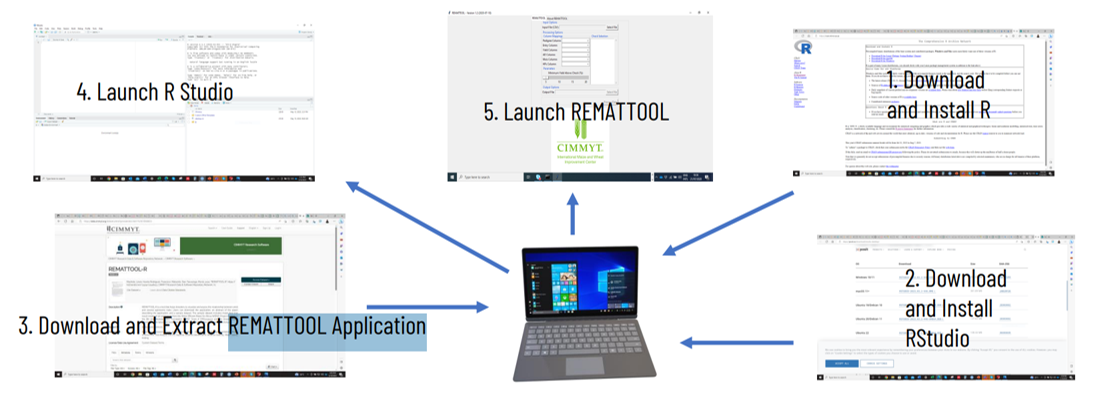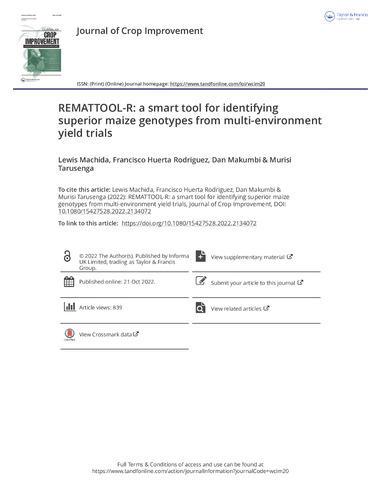REMATTOOL-R: a smart tool for identifying superior maize genotypes from multienvironment yield trial

REMATTOOL-R is a robust, simple, user-friendly, and easily comprehensible tool, convenient for identifying superior genotypes during all the trial stages of a maize breeding program. It is a robust, simple to use and understand, single location/multilocation means-based, and freely available, yield- and maturity-focused crop variety advancement tool. It is a tool that is expected to be ideal for use by the breeder, researcher, non-technical crop variety release committee members, and policymakers in crop variety replacement.
REMATTOOL-R aids breeders in visualizing and assessing the relationships between yield and certain agronomic traits, viz., days to anthesis, percent harvest grain moisture content, and number of harvested plants, and help them in advancing experimental hybrids to the next stage. This tool uses either Best Linear Unbiased Estimators (BLUEs) or Best Linear Unbiased Predictors (BLUPs) of yield and agronomic traits from multilocation trials to perform various computations. The various computations produce graphical and tabular visualizations of the relationship between grain yield and days to anthesis, moisture content, and number of harvested plants that can be used to support selection decisions by the breeder.
REMATTOOL-R output tables show entries with at least 5% higher yield than the check varieties in the trial. Hence, when using this tool, it is expected that there will be no unintended loss of genetic gains in all maturity categories since new higher-yielding varieties with the same or earlier relative maturity against each of the check varieties will be easily identifiable and hence advanced accordingly.
General Requirements for REMATTOOL

In what context is this tool useful?
This tool is useful in a context where breeders routinely evaluate many experimental hybrids that may be of different maturities. In maize (Zea mays L.), days to 50% anthesis and percent grain moisture content are used as proxies for relative maturity. The lack of an easy-to-use statistical tool that gives yield potential of all entries in a trial while classifying them into different relative maturity categories in a single visualization makes it difficult to quickly assess superior genotypes.
In sub-Saharan Africa, it is common to evaluate maize hybrids with somewhat different maturities in a single trial. In general, grain yield is considered the most important trait in the national performance trials (NPTs) and the preceding evaluation trials. Thus, maize hybrid selections for advancement are made mostly for high grain yield, and often late-maturing varieties can be inadvertently selected for advancement unless a conscious effort is made to get the appropriate variety for the early and medium maturity ranges.
However, there is no efficient and effective tool to assist the breeder in speedily conducting variety selection for high-yielding varieties while ensuring that relative maturity of the advanced variety remains the same as the check. Thus, it would be desirable to provide the researcher with a simple tool for quickly identifying high-yielding varieties within each relative maturity category.
REMATTOOL-R is a statistical tool that allows plant breeders to visualize and utilize the relationship between grain yield, relative maturity proxies (days to 50% anthesis or percent grain moisture content), and plant stand to identify superior varieties in a single step, regardless of whether the trial was conducted at a single location or in multiple environments.
Expected results
The use of REMATTOOL-R software:
- Facilitates quick identification of the best performing entries in a trial compared to the practice of most public-sector breeders in the developing world.
- Provides options to the user whether to use days to anthesis or percent grain moisture content or a combination of both in grouping cultivars into maturity groups and identify the best performer for each relative maturity group.
- Allows the quick preliminary assessment of the presence or absence of genetic gains.
- Brings simplicity to targeted variety replacement in variety release committee meetings since the selection decisions are based on overall means.
REMATTOOL is handy for advancements at the preliminary variety testing stage in breeding programs since this stage is usually constrained by many entries and limited seed quantities that in most cases do not allow for multilocation evaluation.
REMATTOOL x-y graphs have also been shown to be useful in easily determining and confirming the expected relative order of days to anthesis or grain moisture content values of the check varieties from the earliest to the latest-maturing entry. This is very important since it complements the heritability values in informing researchers about the quality of flowering data for each trial and deciding on which of the trials can be included in combined analyses.
Because of its ability to display yield levels and relative maturities in a single visualization, REMATTOOL is proposed as part of the breeder’s toolkit for speeding up the development of varieties. Thus, the breeder is expected to be empowered to easily identify and select new cultivars with similar or earlier maturity coupled with similar plant densities but yielding (5%, or 10%, or 15%, or 20%) higher than the targeted check varieties in a trial. This is expected to bring simplicity and efficiency to the variety-advancement process at all stages in the variety-development and release process. For the non-technical participants in variety-release panels or committees, and/or policymaking committees, the x-y graphs from this tool will be simple and easy to comprehend.


